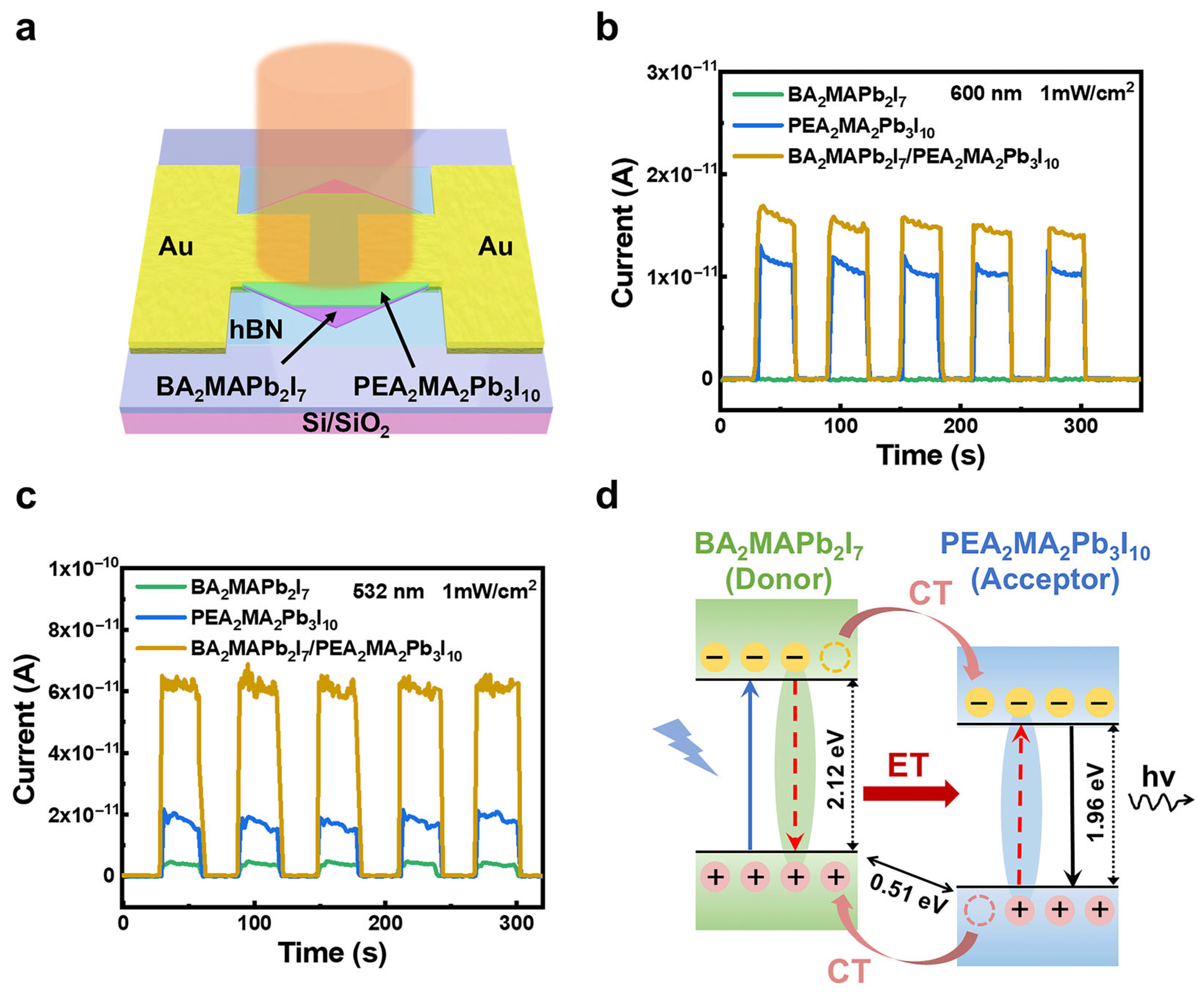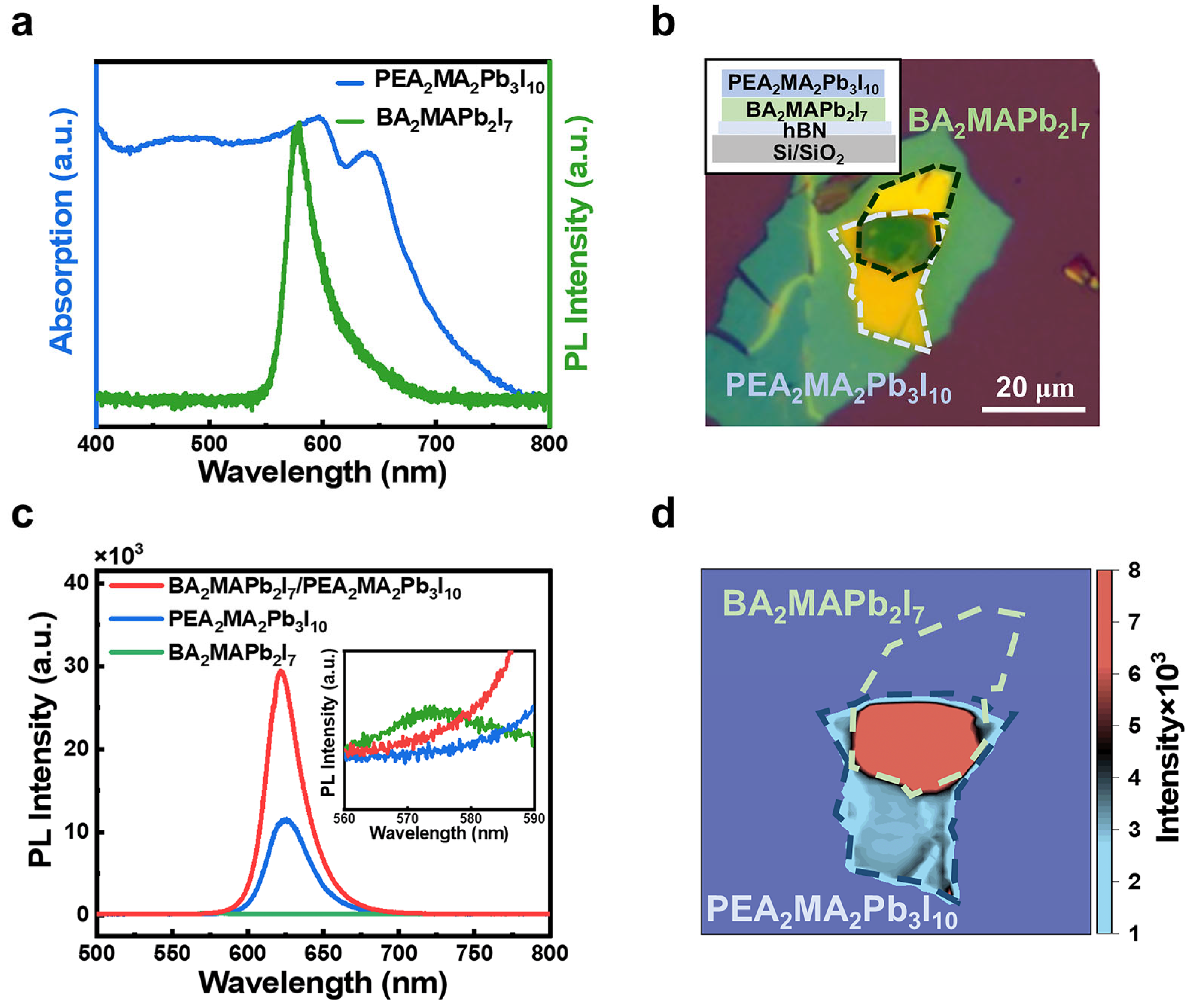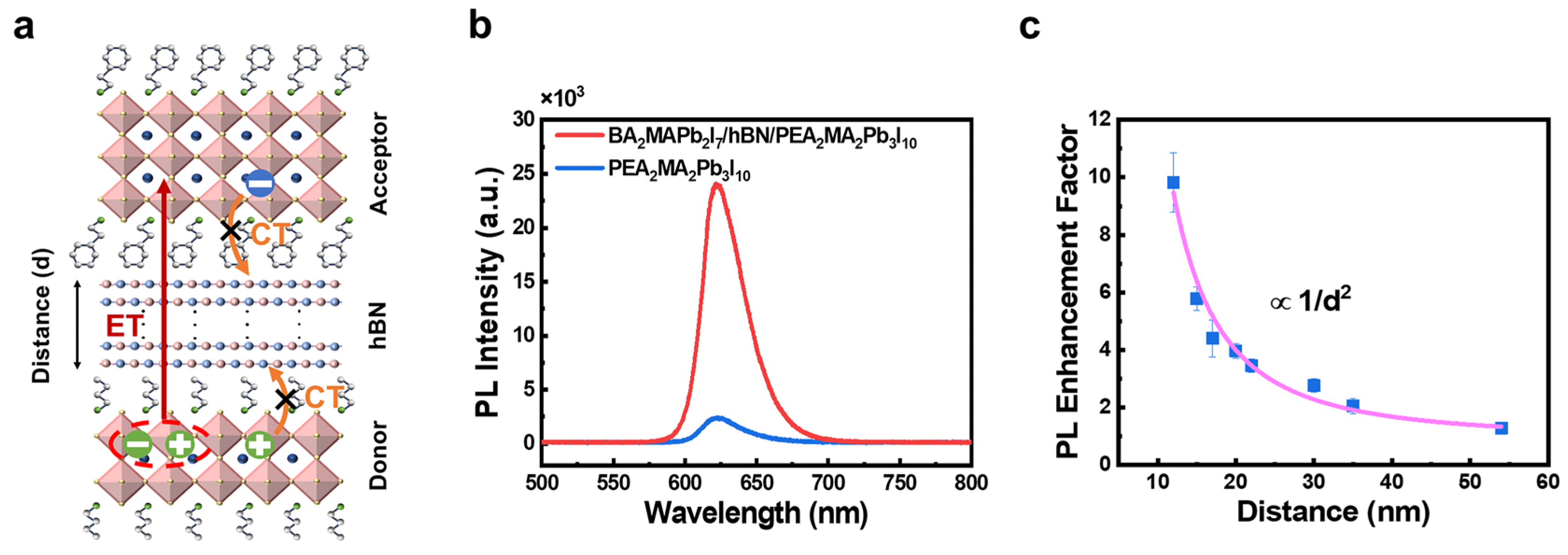Photodetection Enhancement via Dipole–Dipole Coupling in BA2MAPb2I7/PEA2MA2Pb3I10 Perovskite Heterostructures
Abstract
1. Introduction
2. Results and Discussion
3. Materials and Methods
3.1. Synthesis and Sample Preparation
3.2. Heterostructure Fabrication
3.3. Characterization
3.4. Device Fabrication and Characterization
4. Conclusions
Supplementary Materials
Author Contributions
Funding
Institutional Review Board Statement
Informed Consent Statement
Data Availability Statement
Conflicts of Interest
References
- Shrestha, S.; Li, X.; Tsai, H.; Hou, C.-H.; Huang, H.-H.; Ghosh, D.; Shyue, J.-J.; Wang, L.; Tretiak, S.; Ma, X.; et al. Long Carrier Diffusion Length in Two-Dimensional Lead Halide Perovskite Single Crystals. Chem 2022, 8, 1107–1120. [Google Scholar] [CrossRef]
- Kong, L.; Zhang, X.; Li, Y.; Wang, H.; Jiang, Y.; Wang, S.; You, M.; Zhang, C.; Zhang, T.; Kershaw, S.V.; et al. Smoothing the Energy Transfer Pathway in Quasi-2D Perovskite Films Using Methanesulfonate Leads to Highly Efficient Light-Emitting Devices. Nat. Commun. 2021, 12, 1246. [Google Scholar] [CrossRef] [PubMed]
- Wang, R.; Dong, X.; Ling, Q.; Fu, Q.; Hu, Z.; Xu, Z.; Zhang, H.; Li, Q.; Liu, Y. Spacer Engineering for 2D Ruddlesden–Popper Perovskites with an Ultralong Carrier Lifetime of Over 18 Μs Enable Efficient Solar Cells. ACS Energy Lett. 2022, 7, 3656–3665. [Google Scholar] [CrossRef]
- Mandal, A.; Roy, S.; Mondal, A.; Gupta, S.; Pal, B.; Bhattacharyya, S. Spacer Switched Two-Dimensional Tin Bromide Perovskites Leading to Ambient-Stable Near-Unity Photoluminescence Quantum Yield. J. Phys. Chem. Lett. 2022, 13, 9103–9113. [Google Scholar] [CrossRef]
- Li, D.; Xing, Z.; Meng, X.; Hu, X.; Hu, T.; Chen, Y. Spontaneous Internal Encapsulation via Dual Interfacial Perovskite Heterojunction Enables Highly Efficient and Stable Perovskite Solar Cells. Nano Lett. 2023, 23, 3484–3492. [Google Scholar] [CrossRef]
- Zhao, D.; Gao, D.; Wu, X.; Li, B.; Zhang, S.; Li, Z.; Wang, Q.; Wu, Z.; Zhang, C.; Choy, W.C.H.; et al. Efficient and Stable 3D/2D Perovskite Solar Cells through Vertical Heterostructures with (BA)4AgBiBr8 Nanosheets. Adv. Mater. 2022, 34, 2204661. [Google Scholar] [CrossRef]
- Sun, C.; Jiang, Y.; Cui, M.; Qiao, L.; Wei, J.; Huang, Y.; Zhang, L.; He, T.; Li, S.; Hsu, H.-Y.; et al. High-Performance Large-Area Quasi-2D Perovskite Light-Emitting Diodes. Nat. Commun. 2021, 12, 2207. [Google Scholar] [CrossRef] [PubMed]
- Mishra, J.K.; Yantara, N.; Kanwat, A.; Furuhashi, T.; Ramesh, S.; Salim, T.; Jamaludin, N.F.; Febriansyah, B.; Ooi, Z.E.; Mhaisalkar, S.; et al. Defect Passivation Using a Phosphonic Acid Surface Modifier for Efficient RP Perovskite Blue-Light-Emitting Diodes. ACS Appl. Mater. Interfaces 2022, 14, 34238–34246. [Google Scholar] [CrossRef]
- Han, B.; Liu, B.; Wang, G.; Qiu, Q.; Wang, Z.; Xi, Y.; Cui, Y.; Ma, S.; Xu, B.; Hsu, H.-Y. Transparent and Reusable Nanostencil Lithography for Organic–Inorganic Hybrid Perovskite Nanodevices. Adv. Funct. Mater. 2023, 33, 2300570. [Google Scholar] [CrossRef]
- Wang, G.; Han, B.; Mak, C.H.; Liu, J.; Liu, B.; Liu, P.; Hao, X.; Wang, H.; Ma, S.; Xu, B.; et al. Mixed-Dimensional van Der Waals Heterostructure for High-Performance and Air-Stable Perovskite Nanowire Photodetectors. ACS Appl. Mater. Interfaces 2022, 14, 55183–55191. [Google Scholar] [CrossRef]
- Bera, K.P.; Hanmandlu, C.; Lin, H.-I.; Ghosh, R.; Gudelli, V.K.; Lai, C.-S.; Chu, C.-W.; Chen, Y.-F. Fabry–Perot Oscillation and Resonance Energy Transfer: Mechanism for Ultralow-Threshold Optically and Electrically Driven Random Laser in Quasi-2D Ruddlesden–Popper Perovskites. ACS Nano 2023, 17, 5373–5386. [Google Scholar] [CrossRef] [PubMed]
- Lei, L.; Dong, Q.; Gundogdu, K.; So, F. Metal Halide Perovskites for Laser Applications. Adv. Funct. Mater. 2021, 31, 2010144. [Google Scholar] [CrossRef]
- Pan, D.; Fu, Y.; Spitha, N.; Zhao, Y.; Roy, C.R.; Morrow, D.J.; Kohler, D.D.; Wright, J.C.; Jin, S. Deterministic Fabrication of Arbitrary Vertical Heterostructures of Two-Dimensional Ruddlesden-Popper Halide Perovskites. Nat. Nanotechnol. 2021, 16, 159–165. [Google Scholar] [CrossRef]
- Rahil, M.; Ansari, R.; Prakash, C.; Islam, S.; Dixit, A.; Ahmad, S. Ruddlesden–Popper 2D Perovskites of Type (C6H9C2H4NH3)2(CH3NH3)n−1PbnI3n+1 (n = 1–4) for Optoelectronic Applications. Sci. Rep. 2022, 12, 2176. [Google Scholar]
- Gao, C.; Jia, S.; Yin, X.; Li, Z.; Yang, G.; Chen, J.; Li, Z.; An, X. Enhancing Open-Circuit Voltage in FAPbI3 Perovskite Solar Cells via Self-Formation of Coherent Buried Interface FAPbIx Cl3−x. Chem. Commun. 2025, 61, 2758–2761. [Google Scholar] [CrossRef]
- Zhu, B.; Wang, Z.; Zhang, Y.; Yu, Z.; Shi, J.; Xiong, R. Low Temperature Fabrication of the Giant Dielectric Material CaCu3Ti4O12 by Oxalate Coprecipitation m Ethod. Mater. Chem. Phys. 2009, 113, 746–748. [Google Scholar] [CrossRef]
- Li, N.; Hu, X.; Tang, Y.; Lei, Y.; Suet Lau, Y.; Chen, Q.; Sui, X.; Zhu, F. Perovskite/Organic Tandem Device to Realize Light Detection and Emission Dual Function. Chem. Eng. J. 2024, 490, 151573. [Google Scholar] [CrossRef]
- Jia, S.; Li, Y.; Gao, C.; Liu, G.; Ren, Y.; He, C.; An, X.-T. Realization of P-Type MA-Based Perovskite Solar Cells Based on Exposure of the (002) Facet. Appl. Phys. Lett. 2025, 126, 023908. [Google Scholar] [CrossRef]
- Zhu, B.P.; Guo, W.K.; Shen, G.Z.; Zhou, Q.; Shung, K.K. Structure and Electrical Properties of (111)-Oriented Pb(Mg1/3Nb2/3)O3-PbZrO3-PbTiO3 Thin Film for Ultra-High-Frequency Transducer Applications. IEEE Trans. Ultrason. Ferroelectr. Freq. Control 2011, 58, 1962–1967. [Google Scholar] [CrossRef]
- Min, L.; Tian, W.; Cao, F.; Guo, J.; Li, L. 2D Ruddlesden–Popper Perovskite with Ordered Phase Distribution for High-Performance Self-Powered Photodetectors. Adv. Mater. 2021, 33, 2101714. [Google Scholar]
- Zhang, F.; Lu, H.; Tong, J.; Berry, J.J.; Beard, M.C.; Zhu, K. Advances in Two-Dimensional Organic-Inorganic Hybrid Perovskites. Energy Environ. Sci. 2020, 13, 1154–1186. [Google Scholar]
- Han, B.; Qiu, Q.; Tang, Y.; Lian, B.; Liu, B.; Ding, S.; Ma, S.; Luo, M.; Wang, W.; Xu, B.; et al. Manipulating Interlayer Carrier Relaxation Dynamics in Type-II Heterostructures of 2D Hybrid Perovskites Through Organic Spacer Engineering. Adv. Funct. Mater. 2024, 35, 2417167. [Google Scholar] [CrossRef]
- Hu, Z.; Liu, X.; Hernandez-Martinez, P.L.; Zhang, S.; Gu, P.; Du, W.; Xu, W.; Demir, H.V.; Liu, H.; Xiong, Q. Interfacial Charge and Energy Transfer in van Der Waals Heterojunctions. InfoMat 2022, 4, e12290. [Google Scholar] [CrossRef]
- Li, C.; Loh, K.; Leng, K. Organic-Inorganic Hybrid Perovskites and Their Heterostructures. Matter 2022, 5, 4153–4169. [Google Scholar] [CrossRef]
- Song, Y.; Zhang, C.; Liu, W.; Li, X.; Long, H.; Wang, K.; Wang, B.; Lu, P. High-Efficiency Energy Transfer in Perovskite Heterostructures. Opt. Express 2018, 26, 18448–18456. [Google Scholar] [CrossRef]
- Cheng, C.; Li, Z.; Hambarde, A.; Deotare, P. Efficient Energy Transfer across Organic–2D Inorganic Heterointerfaces. ACS Appl. Mater. Interfaces 2018, 10, 39336–39342. [Google Scholar] [CrossRef]
- Zhang, Q.; Linardy, E.; Wang, X.; Eda, G. Excitonic Energy Transfer in Heterostructures of Quasi-2D Perovskite and Monolayer WS2. ACS Nano 2020, 14, 11482–11489. [Google Scholar] [CrossRef]
- Luo, Z.; Yi, X.; Jiang, Y.; Luo, N.; Liu, B.; Zhong, Y.; Tan, Q.; Jiang, Q.; Liu, X.; Chen, S.; et al. Efficient Energy Transfer Enabled by Dark States in van Der Waals Heterostructures. ACS Nano 2024, 18, 31215–31224. [Google Scholar] [CrossRef]
- Han, B.; Tang, Y.; Qiu, Q.; Lian, B.; Liu, B.; Ding, S.; Ma, S.; Li, G.; Xu, B.; Hsu, H.-Y. Enhancing Photodetector Performance via Interlayer Energy Transfer in 2D Hybrid Perovskite Heterostructures. J. Phys. D Appl. Phys. 2025, 58, 135115. [Google Scholar] [CrossRef]
- Sheng, S.; Li, Y.; Xia, M.; Shi, E. Quasi-2D Halide Perovskite Crystals and Their Optoelectronic Applications. J. Mater. Chem. A 2022, 10, 19169–19183. [Google Scholar] [CrossRef]
- Pan, B.; Dou, Z.; Su, M.; Li, Y.; Wu, J.; Chang, W.; Wang, P.; Zhang, L.; Zhao, L.; Zhao, M.; et al. Direct Selective Epitaxy of 2D Sb2Te3 onto Monolayer WS2 for Vertical p–n Heterojunction Photodetectors. Nanomaterials 2024, 14, 884. [Google Scholar] [CrossRef]
- Fu, L.; Sun, Y.; Wu, N.; Mendes, R.; Chen, L.; Xu, Z.; Zhang, T.; Rümmeli, M.; Rellinghaus, B.; Pohl, D.; et al. Direct Growth of MoS2/h-BN Heterostructures via a Sulfide-Resistant Alloy. ACS Nano 2016, 10, 2063–2070. [Google Scholar] [CrossRef] [PubMed]
- Wang, Q.; Wee, A. Photoluminescence Upconversion of 2D Materials and Applications. J. Phys.-Condens. Mat. 2021, 33, 223001. [Google Scholar]
- Kaplan, D.; Gong, Y.; Mills, K.; Swaminathan, V.; Ajayan, P.M.; Shirodkar, S.; Kaxiras, E. Excitation Intensity Dependence of Photoluminescence from Monolayers of MoS2 and WS2/MoS2 Heterostructures. 2D Mater. 2016, 3, 015005. [Google Scholar] [CrossRef]
- Raja, A.; Waldecker, L.; Zipfel, J.; Cho, Y.; Brem, S.; Ziegler, J.D.; Kulig, M.; Taniguchi, T.; Watanabe, K.; Malic, E.; et al. Dielectric Disorder in Two-Dimensional Materials. Nat. Nanotechnol. 2019, 14, 832–837. [Google Scholar] [CrossRef]
- Karmakar, A.; Al-Mahboob, A.; Petoukhoff, C.E.; Kravchyna, O.; Chan, N.S.; Taniguchi, T.; Watanabe, K.; Dani, K.M. Dominating Interlayer Resonant Energy Transfer in Type-II 2D Heterostructure. ACS Nano 2022, 16, 3861–3869. [Google Scholar] [CrossRef]
- Karmakar, A.; Kazimierczuk, T.; Antoniazzi, I.; Raczyński, M.; Park, S.; Jang, H.; Taniguchi, T.; Watanabe, K.; Babiński, A.; Al-Mahboob, A.; et al. Excitation-Dependent High-Lying Excitonic Exchange via Interlayer Energy Transfer from Lower-to-Higher Bandgap 2D Material. Nano Lett. 2023, 23, 5617–5624. [Google Scholar] [CrossRef]
- Karmakar, A.; Al-Mahboob, A.; Zawadzka, N.; Raczyński, M.; Yang, W.; Arfaoui, M.; Gayatri; Kucharek, J.; Sadowski, J.T.; Shin, H.S.; et al. Twisted MoSe2 Homobilayer Behaving as a Heterobilayer. Nano Lett. 2024, 24, 9459–9467. [Google Scholar] [CrossRef]
- Li, Y.; Zeng, Y.; Ou, Z.; Dai, W.; Wang, C.; Li, Z.; Li, W.; Yan, J.; Yu, S.; Yu, Y.; et al. Tunability of the Energy Transfer Process in Type-II Heterostructures. ACS Photonics 2024, 11, 3722–3729. [Google Scholar] [CrossRef]
- Lin, T.N.; Huang, L.T.; Shu, G.W.; Yuan, C.T.; Shen, J.L.; Lin, C.A.J.; Chang, W.H.; Chiu, C.H.; Lin, D.W.; Lin, C.C.; et al. Distance Dependence of Energy Transfer from InGaN Quantum Wells to Graphene Oxide. Opt. Lett. 2013, 38, 2897. [Google Scholar] [CrossRef] [PubMed]
- Itskos, G.; Heliotis, G.; Lagoudakis, P.G.; Lupton, J.; Barradas, N.P.; Alves, E.; Pereira, S.; Watson, I.M.; Dawson, M.D.; Feldmann, J.; et al. Efficient Dipole-Dipole Coupling of Mott-Wannier and Frenkel Excitons in (Ga, In) N Quantum Well/Polyfluorene Semiconductor Heterostructures. Phys. Rev. B 2007, 76, 035344. [Google Scholar] [CrossRef]
- Wang, K.; Wu, C.; Yang, D.; Jiang, Y.; Priya, S. Quasi-Two-Dimensional Halide Perovskite Single Crystal Photodetector. ACS Nano 2018, 12, 4919–4929. [Google Scholar] [CrossRef]
- Peng, W.; Yin, J.; Ho, K.; Ouellette, O.; De Bastiani, M.; Murali, B.; El Tall, O.; Shen, C.; Miao, X.; Pan, J.; et al. Ultralow Self-Doping in Two-Dimensional Hybrid Perovskite Single Crystals. Nano Lett. 2017, 17, 4759–4767. [Google Scholar] [CrossRef]




Disclaimer/Publisher’s Note: The statements, opinions and data contained in all publications are solely those of the individual author(s) and contributor(s) and not of MDPI and/or the editor(s). MDPI and/or the editor(s) disclaim responsibility for any injury to people or property resulting from any ideas, methods, instructions or products referred to in the content. |
© 2025 by the authors. Licensee MDPI, Basel, Switzerland. This article is an open access article distributed under the terms and conditions of the Creative Commons Attribution (CC BY) license (https://creativecommons.org/licenses/by/4.0/).
Share and Cite
Han, B.; Lian, B.; Qiu, Q.; Liu, X.; Tang, Y.; Lin, M.; Ding, S.; Xu, B. Photodetection Enhancement via Dipole–Dipole Coupling in BA2MAPb2I7/PEA2MA2Pb3I10 Perovskite Heterostructures. Inorganics 2025, 13, 240. https://doi.org/10.3390/inorganics13070240
Han B, Lian B, Qiu Q, Liu X, Tang Y, Lin M, Ding S, Xu B. Photodetection Enhancement via Dipole–Dipole Coupling in BA2MAPb2I7/PEA2MA2Pb3I10 Perovskite Heterostructures. Inorganics. 2025; 13(7):240. https://doi.org/10.3390/inorganics13070240
Chicago/Turabian StyleHan, Bin, Bingtao Lian, Qi Qiu, Xingyu Liu, Yanren Tang, Mengke Lin, Shukai Ding, and Bingshe Xu. 2025. "Photodetection Enhancement via Dipole–Dipole Coupling in BA2MAPb2I7/PEA2MA2Pb3I10 Perovskite Heterostructures" Inorganics 13, no. 7: 240. https://doi.org/10.3390/inorganics13070240
APA StyleHan, B., Lian, B., Qiu, Q., Liu, X., Tang, Y., Lin, M., Ding, S., & Xu, B. (2025). Photodetection Enhancement via Dipole–Dipole Coupling in BA2MAPb2I7/PEA2MA2Pb3I10 Perovskite Heterostructures. Inorganics, 13(7), 240. https://doi.org/10.3390/inorganics13070240




